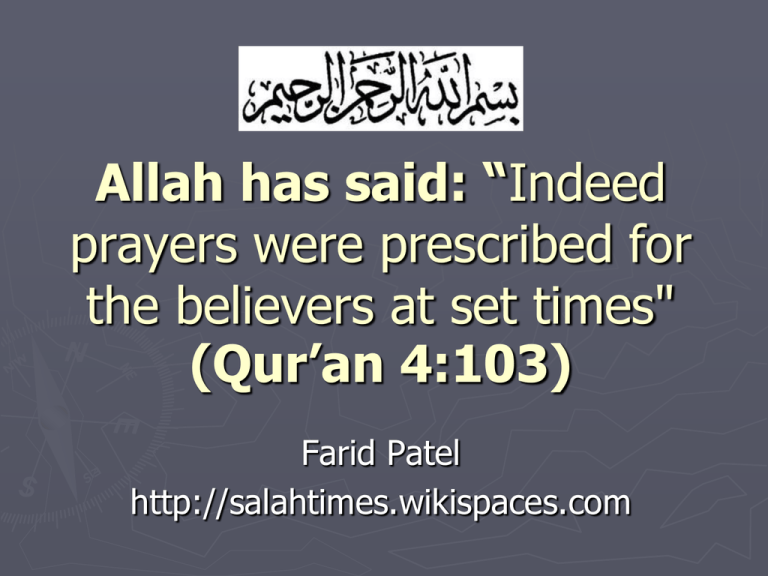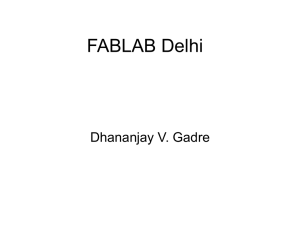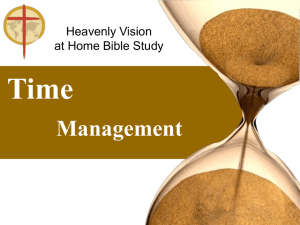Correct Mushahadah Subh Sadiq 18 Degrees Presentation
advertisement

Allah has said: “Indeed prayers were prescribed for the believers at set times" (Qur’an 4:103) Farid Patel http://salahtimes.wikispaces.com Responsibility Imam Ibn Abideen As-Shami رمحه اهللwrites in Radd Al-Muhtar: “It is Fardh (obligatory) for every person to know the injunctions that apply to his every day life so that he can avoid falling into Haraam.” (Volume 1, Page 42) Two Claims 1. 2. 18 degrees is the time ‘Ulama from around the world have approved for at least the last 1,000 years. The timetable adopted by many Masajid in 1989 and other Masajid last year does not have the approval of the scholars who have scrutinised it. 18 degrees approved over 950 years ago! ► Allamah Abu Rayhan Al Birooni (d:440 Hijri, 1048): ‘When the sun descends to 18 degrees below the horizon in the East, that is the commencement of Fajr (Subah Sadiq).’ (Al Qanun Al-Mas’udi, vol 2, ch 8, heading 13) ► Since 950 years ago, the specialist researchers during that time, established that 18 degrees is the correct commencement of Subah Sadiq ?When does Fajr begin َو ُكلُواْ َو ۡ ن ْۡٱل َف ۡج ِرْۖ ن ۡٱل َخ ۡي ِطْ ۡٱۡلَ ۡس َو ِْد ِم َْ ط ٱ ۡۡلَ ۡب َيضُْ ِم َْ َّن لَ ُك ُُم ۡٱل َخ ۡي ُْ ٱش َربُواْ َح َّتىْ َي َت َبي َْ Allah, the Most High, says: "Eat and drink until the white thread becomes distinct to you from the black thread of the dawn. Then resume the ]fast till nightfall ... " [Al-Qur'ân 2:187 Imam Qurtubi on pg 214:2: ممتداً كاخليط . ....ومسَي الفجر خيطا ألن ما يبدو من البياض يرى َ واخليط ىف كالمهم عبارة عن اللون .والفجر مصدر فجرت املاء أفجره فجرا إذا جرى وانبعث , وأصله الشق ,فلذالك قيل للطالع من تباشري ضياء الشمس من مطلعها :فجرا النبعاث ضوئه ,وهو أول بياض النهار الظاهر املستطري يف األفق املنتشر ,تسميه العرب اخليط األبيض Subh Kazib Subh Sadiq Differences between Subh Sadiq and Subh Kazib Differences between Subh Sadiq and Subh Kazib What is Galas? In light of the Sahih Hadith, Imam Malik, Imam Bukhari Imam Tirmidith r.a. related through Sayyida Aisha r.a: ‘We, the Muslim women would attend the morning prayer behind the Prophet s.a.w. with our bodies covered in sheets. After the prayer, when we would return home, (Al Galas) due to the darkness we could not recognise each other.’ (Muwatta Imam Malik, #4/ Sahih Bukhari #578/ Jami Tirmidith vol 1, p40) Hafiz Ibn Hajar Al Asqalani r.a. writes: ‘due to the darkness we could not recognise each other’ means, due to the darkness they could distinguish the form of a body but not recognise whether it was Khadija or Zainab.’ (Fathul Bari Sharah Bukhari vol 2, p22) In this Hadith ‘Al Ghalas’ is translated by expert translators of the Arabic language (lexicographer) as ‘the last part of the darkness of the night which is joined to the first light of the day.’ (Lisanul Arab/ Majma’ul Bahar, vol 4, p52) Shaykhul Hadith Maulana Zakariya Kandhalawi r.a. uses the statement of Ibn Atheer r.a. to explain the meaning of ‘Al Ghalas’ in the same manner. (Awjazul Masalik Shara Muwatta Imam Malik, vol 1, p273) Mufti Yusuf Danka Ahadith When does Fajr begin? Is it at first light or is it when the whiteness spreads? Two terms used “Galas” and “Isfaar” Let’s look at the evidence for this. Ahadith )When does Fajr start? (Tirmidhī 149 روي أن النيب صلى اهلل عليه وسلم قال :أمين جربيل عليه السالم عند البيت مرتني . فصلى الظهر يف األوىل منهما حني زالت الشمس وكان الفيء مثل الشراك مث صلى العصر حني كان كل شيء مثل ظله مث صلى املغرب حني وجبت الشمس وأفطر الصائم مث صلى العشاء حني غاب الشفق ثم صلى الفجر حين برق الفجر وحرم الطعام على الصائم وصلى املرة الثانية الظهر حني كان ظل كل شيء مثله لوقت العصر باألمس مث صلى العصر حني كان ظل كل شيء مثليه مث صلى املغرب لوقته األول مث صلى العشاء اآلخرة حني ذهب ثلث الليل مث صلى الصبح حني أسفرت األرض .مث التفت إيل جربيل فقال :يا حممد هذا وقت األنبياء من قبلك ،والوقت فيما بني هذين الوقتني There are also Ahadith on Isfar however … Fatwa of Ibn Uthaymeen What is twilight? If the earth did not have an atmosphere, the sky would become dark immediately after sunset. The earth's atmosphere causes scattering of sunlight so that light reaches the observer before sunrise and after sunset. This scattered light is called twilight. After sunset, as the depression of the sun increases the sky gets darker and darker until no scattered light reaches the observer. Conversely, in the morning light starts to appear in the sky even before sunrise. The morning twilight is called dawn whilst the evening twilight is known as dusk. What is 18 degrees? In astronomy the twilight period is divided into civil, nautical and astronomical twilight corresponding to solar depressions of 6, 12 and 18 degrees respectively. Civil twilight - roughly equivalent to lighting up time. The brightest stars are visible and at sea the horizon is clearly visible. Nautical twilight - the horizon at sea ceases to be clearly visible and it is impossible to determine altitudes with reference to the horizon. Astronomical twilight- when it is truly dark and no perceptible twilight remains. Introduction ► The solar depression angles are based on widespread actual sightings. ► Calculations have been used for more than 1,000 years. ► Prayer times can be decided using calculations, in contrast with the Islamic months where physical sighting of the moon is required. ► Fiqh Council of MWL confirmed 18º for Fajr in 2007 for Belgium. (Shaykh Ibn Uthaymeen and AlFawzan where members of the council at this time) What is 18 degrees? History Here is a brief extract from chapter five of Dr. Ilyas' book (in italics): " In modern times, astronomical twilight (18 degrees) has come to be widely used for the determination of isha and fajr times. As the average intensity curve of evening twilight indicates, the flux decreases to a minimum level, and thus it would seem appropriate that even for Islamic purposes, this should indicate a reasonable starting value for the end of 'astro-lslamic twilight' (AIT). Indeed, 18 degrees depression was a commonly used value for fajr and isha in the medieval period, when it must have been based on careful observations. Nevertheless, slight variations from this value- between 16 degrees and 20 degrees- were also used during the medieval period. According to King, 20 degrees and 16 degrees were the parameters used by Ibn Yunus for morning and evening AIT respectively, whereas 19 degrees and 17 degrees were the parameters used by various Egyptian astronomers. Nasr also refers to 19 degrees being used in the Islamic world for the fajr and isha times. King has confirmed that although Muslim astronomers widely used 18 degrees/l8 degrees symmetrical values or a slight variation to 19 degrees/17 degrees (morning/evening)-and in a few (earlier) cases even 20 degrees/16 degrees values were adopted-no record has been found of the use of a value as small as 15 degrees. (Astronomy of Islamic Times for the Twenty- first Century). When do the modern Scholars say Fajr and ‘Isha occur? Organisation University of Islamic Sciences, Karachi Fajr-twilight angle Isha-twilight angle Region Pakistan, India, Bangladesh, Afghanistan, parts of Europe 18 18 Islamic Society of North America (ISNA) 18 18 Parts of USA & Canada, parts of UK Muslim World League 18 17 Europe, Far East, parts of USA Umm-Al-Qura, Makkah 19 Egyptian General Organisation of Surveying 19.5 90 mins after Maghrib, 120 mins during Ramadhan 17.5 Arabian Peninsula Africa, Syria, Iraq, Lebanon, Malaysia, parts of USA Observations Locations chosen where light pollution does not hinder the horizon have given very similar results. Green dots are locations that have shown Fajr and Isha times at times similar to those around the world. The red dots are observations which have given later subh sadiq times. What about Salah Times in the Summer? Why is it an issue? Solutions Hadith of Sahih Muslim Dajjal “Will one day’s prayer suffice for the prayers of the day equal to one year?” “No, but you must make an estimate of the time.” Imam Nawawi رحمه هللاmentions 4 methods: 1) 2) 3) 4) Nearest Day Nearest city One seventh Half Night Salat - ul ‘Isha Although the scholars also believe that ‘Isha should also occur at 17 or 18 degrees there is some leeway in this due to the differences with regards to the evidences and also Ahadith that give the impression that ‘Isha time is not as fixed as Fajr. When should a person perform ‘Isha in Summer? Opinion 1: Pray at correct time, even if late. Opinion 2: Pray at an estimated time. Opinion 3: Combine Isha with Maghrib and pray at Maghrib time. All these opinions have their merits and weaknesses. When to Pray Isha in Summer The male adult should join the congregational prayer in the mosque that he usually prays in, whether they combine or chose any criteria for estimation. For those who pray at home, pray Isha as close as you can to the Shariah time. Combining Isha with Maghrib at home should not be a habit, especially when there is no pressing need. Claim 2: The timetable currently used by many Masajid in the UK is not acceptable according to Shari’ah. Salah Times in the UK Many towns and cities of the UK are currently using a timetable devised by Hizbul Ulama UK also known as Moonsighting.com or Unified London Timetable. The claims in the timetable appear to be perfect, and yet an investigation into the claims reveal glaring and serious errors. These flaws have been put forward to Hizbul Ulama who have failed to adequately respond to them. 2) Hizb-ul-Ulama timetable times are different to their own observed times. Study the evidence in the following slides: Examples of Errors At this meeting following was agreed: For May and June Fajr beginning time be set at the recorded time of Tabayyun as is permitted by the Muftiyaane Kiram. (Fajr and Isha times and Twilight, page 113, Ml Y. Miftahi). Likewise for Fajar, the times observed for First Light would be used except for summer when the times observed for Tabayyun (spreading of light along the horizon) would be used. Again times will need to be phased to get from one to the other. This method results in some times that are “in between” times. This is what the critics object to. However, as this method necessitates phasing to avoid “jumping” times it is perfectly valid particularly as the times are within “hudoode shariah”. Source: (Why Our Fasting Times are not Wrong, pg 7, by Ml Miftahi) Tabayyun times for May & June: Original Observed Times Times recommended to the Public May 15th = 1hour 33mins 1hour 48mins May 22nd = 1hour 32mins 1hour 51mins May 25th = 1hour 44mins 1hour 54mins June 6th = 1hour 43mins 2 hours June 13th = 1hour 54mins 2hours 4mins More Errors 2) Successful Fajr observations were only carried out for 21 days from 365 days 3) Observers did not have the experience of observing 4) The location of observation was subject to light pollution 5) Hizbul Ulama did not identify what they were observing, we don’t know if times are first light or tabyeen or something in between. Salams Mufti Sajid Saheb, further to your request to enquire with Moulana Ahmed Sidat and Qari Gulam Mohammad Patel regarding the 1988 Blackburn Mushahadah, I have spoken with both of them and their replies are presented below: Moulana Ahmed Sidat: My recollection is that on two or maybe three occasions I was at Haji Adam Patel`s house here in Blackburn during the month of Ramadhan after Taraweeh, we used to leave from there late at night and on these occasions Moulana Yakub Miftahi Saheb took me in the car towards the area where the present Asda is and requested me to observe Subah Sadik, I really did not know what was going on but do remember trying to observe Subah Sadik and Moulana Yakub Miftahi Saheb showing me Subah Sadik. I just happened to be present at Haji Adam Patel`s house at those times. Qari Gulam Mohammad Patel: At that time I had been in UK for six years and used to spend a lot of time at my friend/relative Hafez Ahmed Bham`s house on Audley Range, on a few occasions I was at Hafez Ahmed Bham’s house during Ramadhan after Taraweeh when Moulana Yakub Miftahi Saheb came to pick up Hafez Ahmed, Hafez Ahmed informed Moulana Yakub Miftahi that I have a friend/relative at home and Moulana Yakub invited me to join them as well, this happened on five occasions, at one time the late Moulana Ilyas (Imam of the Leytonstone Masjid, London) was present as well and he also joined us, at that time I had been in UK for six years and didn’t know anything about Subah Sadik or Shafaq, I just happened to be at Hafez Ahmed Bham`s house and joined upon invite. Fatwa from Dar Al-Ulum Karachi “These errors (of the Hizbul Ulama Timetable) came about due to a lack of knowledge with regards to (the nature of) Subh Sadiq.” 30th December 1990 Signed by Mufti Taqi Uthmani DB In astronomy the twilight period is divided into civil, nautical and astronomical twilight corresponding to solar depressions of 6, 12 and 18 degrees respectively. Civil twilight - roughly equivalent to lighting up time. The brightest stars are visible and at sea the horizon is clearly visible. Nautical twilight - the horizon at sea ceases to be clearly visible and it is impossible to determine altitudes with reference to the horizon. Astronomical twilight- when it is truly dark and no perceptible twilight remains. Why should we accept the recommendations? 1) Supported with evidence of astronomers and scholars. 2) Supported by observations of experts in UK, Saudi Arabia and other parts of the world. 3) It’s easy to follow.









